Hybrid Ionic Silver and Magnetite Microgels Nanocomposites for Efficient Removal of Methylene Blue
Abstract
:1. Introduction
2. Results
2.1. Characterization of AMPS/AA Nanocomposites
2.2. Application of AMPS/AA Hydrogel and Its Ag and Fe3O4 Composites as Methylene Blue (MB) Adsorbent
2.3. Catalytic of AMPS/AA–Fe3O4 Microgel Nanocomposites
3. Discussion
4. Materials and Methods
4.1. Materials
4.2. Preparation Methods
4.2.1. Synthesis of AMPS/AA Microgel and Hydrogel
4.2.2. Synthesis of AMPS/AA Nanocomposites
4.3. Characterization
4.4. Application of AMPS/AA Hydrogel Composites as Adsorbents
4.5. Application of AMPS/AA Composites as Catalyst
5. Conclusions
Author Contributions
Funding
Acknowledgments
Conflicts of Interest
References
- Khan, M.; Lo, I.M.C. A holistic review of hydrogel applications in the adsorptive removal of aqueous pollutants: Recent progress, challenges, and perspectives. Water Res. 2016, 106, 259–271. [Google Scholar] [CrossRef] [PubMed]
- Atta, A.M.; Ismail, H.S.; Elsaaed, A.M. Application of anionic acrylamide-based hydrogels in the removal of heavy metals from waste water. J. Appl. Polym. Sci. 2012, 123, 2500–2510. [Google Scholar] [CrossRef]
- Thakur, S.; Govender, P.P.; Mamo, M.A.; Tamulevicius, S.; Thakur, V.K. Recent progress in gelatin hydrogel nanocomposites for water purification and beyond. Vacuum 2017, 146, 396–408. [Google Scholar] [CrossRef] [Green Version]
- Parasuraman, D.; Serpe, M.J. Poly (N-Isopropylacrylamide) Microgel-Based Assemblies for Organic Dye Removal from Water. ACS Appl. Mater. Interfaces 2011, 3, 4714–4721. [Google Scholar] [CrossRef] [PubMed]
- Dalaran, M.; Emik, S.; Güçlü, G.; İyim, T.B.; Özgümüş, S. Study on a novel polyampholyte nanocomposite superabsorbent hydrogels: Synthesis, characterization and investigation of removal of indigo carmine from aqueous solution. Desalination 2011, 279, 170–182. [Google Scholar] [CrossRef]
- Atta, A.M.; Abdel-Azim, A.-A.A. Effect of crosslinker functionality on swelling and network parameters of copolymeric hydrogels. Polym. Adv. Technol. 1998, 9, 340–348. [Google Scholar] [CrossRef]
- Ahmed, E.M. Hydrogel: Preparation, characterization, and applications: A review. J. Adv. Res. 2015, 6, 105–121. [Google Scholar] [CrossRef]
- Ullah, F.; Othman, M.B.H.; Javed, F.; Ahmad, Z.; Akil, H.M. Classification, processing and application of hydrogels: A review. Mater. Sci. Eng. C 2015, 57, 414–433. [Google Scholar] [CrossRef]
- Satarkar, N.S.; Biswal, D.; Hilt, J.Z. Hydrogel nanocomposites: A review of applications as remote controlled biomaterials. Soft Matter 2010, 6, 2364. [Google Scholar] [CrossRef]
- Akl, M.A.; Atta, A.M.; Yousef AE, F.M.; Alaa, M.I. Characterization of stabilized porous magnetite core-shell nanogel composites based on crosslinked acrylamide/sodium acrylate copolymers. Polym. Int. 2013, 62, 1667–1677. [Google Scholar] [CrossRef]
- Qiu, Y.; Park, K. Environment-sensitive hydrogels for drug delivery. Adv. Drug Deliv. Rev. 2001, 53, 321–339. [Google Scholar] [CrossRef]
- Pradeep, T. Anshup Noble metal nanoparticles for water purification: A critical review. Thin Solid Films 2009, 517, 6441–6478. [Google Scholar] [CrossRef]
- Adeleye, A.S.; Conway, J.R.; Garner, K.; Huang, Y.; Su, Y.; Keller, A.A. Engineered nanomaterials for water treatment and remediation: Costs, benefits, and applicability. Chem. Eng. J. 2016, 286, 640–662. [Google Scholar] [CrossRef] [Green Version]
- Hua, M.; Zhang, S.; Pan, B.; Zhang, W.; Lv, L.; Zhang, Q. Heavy metal removal from water/wastewater by nanosized metal oxides: A review. J. Hazard. Mater. 2012, 211, 317–331. [Google Scholar] [CrossRef] [PubMed]
- Ren, D.; Colosi, L.M.; Smith, J.A. Evaluating the Sustainability of Ceramic Filters for Point-of-Use Drinking Water Treatment. Environ. Sci. Technol. 2013, 47, 11206–11213. [Google Scholar] [CrossRef] [PubMed]
- Qu, X.; Alvarez, P.J.; Li, Q. Applications of nanotechnology in water and wastewater treatment. Water Res. 2013, 47, 3931–3946. [Google Scholar] [CrossRef]
- Thoniyot, P.; Tan, M.J.; Karim, A.A.; Young, D.J.; Loh, X.J. Nanoparticle-Hydrogel Composites: Concept, Design, and Applications of These Promising, Multi-Functional Materials. Adv. Sci. 2015, 2, 1400010. [Google Scholar] [CrossRef]
- Akl, Z.F.; El-Saeed, S.M.; Atta, A.M. In-situ synthesis of magnetite acrylamide amino-amidoxime nanocomposite adsorbent for highly efficient sorption of U(VI) ions. J. Ind. Eng. Chem. 2016, 34, 105–116. [Google Scholar] [CrossRef]
- Atta, A.M.; Al-Hussain, S.A.; Al-Lohedan, H.A.; Ezzat, A.O.; Tawfeek, A.M.; Al-Otabi, T. In situ preparation of magnetite/cuprous oxide/poly (AMPS/NIPAm) for removal of methylene blue from waste water. Polym. Int. 2018, 67, 471–480. [Google Scholar] [CrossRef]
- Atta, A.M.; Al-Lohedan, H.A.; Tawfeek, A.M.; Ahmed, M.A. In situ preparation of magnetic Fe3 O4 Cu2 O.Fe3 O4 /cryogel nanocomposite powder via a reduction-coprecipitation method as adsorbent for methylene blue water pollutant. Polym. Int. 2018, 67, 925–935. [Google Scholar] [CrossRef]
- Atta, A.M.; Arndt, K.-F. Temperature and pH sensitive ionic hydrogels based on new crosslinkers. Polym. Adv. Technol. 2005, 16, 442–450. [Google Scholar] [CrossRef]
- Al-Hussain, S.A.; Ezzat, A.O.; Gaffer, A.K.; Atta, A.M. Removal of organic water pollutant using magnetite nanomaterials embedded with ionic copolymers of 2-acrylamido-2-methylpropane sodium sulfonate cryogels. Polym. Int. 2018, 67, 166–177. [Google Scholar] [CrossRef]
- Wang, S.Q.; Liu, Q.L.; Zhu, A.M. Preparation of multisensitive poly (N-isopropylacrylamide-co-acrylic acid)/TiO2 composites for degradation of methyl orange. Eur. Polym. J. 2011, 47, 1168–1175. [Google Scholar] [CrossRef]
- Tang, Y.; Wu, T.; Hu, B.; Yang, Q.; Liu, L.; Yu, B.; Ding, Y.; Ye, S. Synthesis of thermo- and pH-responsive Ag nanoparticle-embedded hybrid microgels and their catalytic activity in methylene blue reduction. Mater. Chem. Phys. 2015, 149, 460–466. [Google Scholar] [CrossRef]
- Ambashta, R.D.; Sillanpää, M. Water purification using magnetic assistance: A review. J. Hazard. Mater. 2010, 180, 38–49. [Google Scholar] [CrossRef]
- Gómez-Pastora, J.; Bringas, E.; Ortiz, I. Recent progress and future challenges on the use of high performance magnetic nano-adsorbents in environmental applications. Chem. Eng. J. 2014, 256, 187–204. [Google Scholar] [CrossRef]
- Mehta, D.; Mazumdar, S.; Singh, S. Magnetic adsorbents for the treatment of water/wastewater—A review. J. Water Process. Eng. 2015, 7, 244–265. [Google Scholar] [CrossRef]
- Azeez, F.; Al-Hetlani, E.; Arafa, M.; Abdelmonem, Y.; Nazeer, A.A.; Amin, M.O.; Madkour, M. The effect of surface charge on photocatalytic degradation of methylene blue dye using chargeable titania nanoparticles. Sci. Rep. 2018, 8, 7104. [Google Scholar] [CrossRef]
- Shah, L.A.; Haleem, A.; Sayed, M.; Siddiq, M. Synthesis of sensitive hybrid polymer microgels for catalytic reduction of organic pollutants. J. Environ. Chem. Eng. 2016, 4, 3492–3497. [Google Scholar] [CrossRef]
- Saha, J.; Begum, A.; Mukherjee, A.; Kumar, S. A novel green synthesis of silver nanoparticles and their catalytic action in reduction of Methylene Blue dye. Sustain. Environ. Res. 2017, 27, 245–250. [Google Scholar] [CrossRef]
- Atta, A.M.; Gafer, A.K.; Al-Lohedan, H.A.; Abdullah, M.M.S.; Ezzat, A.O. Preparation of magnetite and silver poly(2-acrylamido-2-methyl propane sulfonic acid- co -acrylamide) nanocomposites for adsorption and catalytic degradation of methylene blue water pollutant. Polym. Int. 2019, 68, 1164–1177. [Google Scholar] [CrossRef]
- Abdel-Azim, A.-A.A.; Farahat, M.S.; Atta, A.M.; Abdel-Fattah, A.A.; Abdel-Azim, A.A.; Abdel-Fattah, A.A. Preparation and properties of two-component hydrogels based on 2-acrylamido-2-methylpropane sulphonic acid. Polym. Adv. Technol. 1998, 9, 282–289. [Google Scholar] [CrossRef]
- Sahiner, N.; Godbey, W.T.; McPherson, G.L.; John, V.T. Microgel, nanogel and hydrogel–hydrogel semi-IPN composites for biomedical applications: Synthesis and characterization. Colloid Polym. Sci. 2006, 284, 1121–1129. [Google Scholar] [CrossRef]
- Tam, K.C.; Ragaram, S.; Pelton, R.H.; Tam, M.K. Interaction of Surfactants with Poly(N-isopropylacrylamide) Microgel Latexes. Langmuir 1994, 10, 418–422. [Google Scholar] [CrossRef]
- Butler, A.; Theisen, R.M. Iron(III)–siderophore coordination chemistry: Reactivity of marine siderophores. Co-ord. Chem. Rev. 2010, 254, 288–296. [Google Scholar] [CrossRef] [PubMed]
- Fox, B.S.; Beyer, M.K.; Bondybey, V.E. Coordination Chemistry of Silver Cations. J. Am. Chem. Soc. 2002, 124, 13613–13623. [Google Scholar] [CrossRef]
- Atta, A.M.; El Wahab, Z.H.A.; El Shafey, Z.A.; Zidan, W.I.; Akl, Z.F. Characterization and Evaluation of Acrylic Acid Co-2-acrylamido-2-methylpropane-1-sulfonic Acid Hydrogels for Uranium Recovery. J. Dispers. Sci. Technol. 2010, 31, 1415–1422. [Google Scholar] [CrossRef]
- Pich, A.; Karak, A.; Lu, Y.; Ghosh, A.K.; Adler, H.-J.P.; Adler, H.P. Preparation of Hybrid Microgels Functionalized by Silver Nanoparticles. Macromol. Rapid Commun. 2006, 27, 344–350. [Google Scholar] [CrossRef]
- Mbhele, Z.; Salemane, M.; Van Sittert, C.; Nedeljković, J.; Djoković, V.; Luyt, A. Fabrication and characterization of silver− polyvinyl alcohol nanocomposites. Chem. Mater. 2003, 15, 5019–5024. [Google Scholar] [CrossRef]
- Fernández-Nieves, A.; Fernández-Barbero, A.; Vincent, B.; Nieves, F.J.D.L. Charge Controlled Swelling of Microgel Particles. Macromolecules 2000, 33, 2114–2118. [Google Scholar] [CrossRef]
- Atta, A.M.; Al-Lohedan, H.A.; Alothman, Z.; Abdel-Khalek, A.A.; Tawfeek, A.M. Characterization of reactive amphiphilic montmorillonite nanogels and its application for removal of toxic cationic dye and heavy metals water pollutants. J. Ind. Eng. Chem. 2015, 31, 374–384. [Google Scholar] [CrossRef]
- Atta, A.M.; Al-Lohedan, H.A.; Ezzat, A.O.; Tawfik, A.M.; Hashem, A.I. Synthesis of zinc oxide nanocomposites using poly (ionic liquids) based on quaternary ammonium acrylamidomethyl propane sulfonate for water treatment. J. Mol. Liq. 2017, 236, 38–47. [Google Scholar] [CrossRef]
- Atta, A.M.; Arndt, K.F. Synthesis and characterization of polyelectrolyte hydrogels with controlled swelling behaviour. Polym. Int. 2001, 50, 1360–1369. [Google Scholar] [CrossRef]
- Atta, A.M.; Al-Lohedan, H.A.; Ezzat, A.O.; Issa, Z.A.; Oumi, A.B. Synthesis and application of magnetite polyacrylamide amino-amidoxime nano-composites as adsorbents for water pollutants. J. Polym. Res. 2016, 23, 69. [Google Scholar] [CrossRef]
- Atta, A.M. Synthesis and characterization of novel core-shell magnetic nanogels based on 2-acrylamido-2-methylpropane sulfonic acid in aqueous media. J. Appl. Polym. Sci. 2012, 124, 3276–3285. [Google Scholar] [CrossRef]
- Yang, Y.; Xie, Y.; Pang, L.; Li, M.; Song, X.; Wen, J.; Zhao, H. Preparation of Reduced Graphene Oxide/Poly(acrylamide) Nanocomposite and Its Adsorption of Pb(II) and Methylene Blue. Langmuir 2013, 29, 10727–10736. [Google Scholar] [CrossRef] [PubMed]
- Munoz, M.; De Pedro, Z.M.; Casas, J.A.; Rodriguez, J.J.; Garcia, M.M. Preparation of magnetite-based catalysts and their application in heterogeneous Fenton oxidation – A review. Appl. Catal. B Environ. 2015, 176, 249–265. [Google Scholar] [CrossRef]
- Pouran, S.R.; Raman, A.A.A.; Daud, W.M.A.W. Review on the application of modified iron oxides as heterogeneous catalysts in Fenton reactions. J. Clean. Prod. 2014, 64, 24–35. [Google Scholar] [CrossRef] [Green Version]
- Chun, J.; Lee, H.; Lee, S.-H.; Hong, S.-W.; Lee, J.; Lee, C.; Lee, J. Magnetite/mesocellular carbon foam as a magnetically recoverable fenton catalyst for removal of phenol and arsenic. Chemosphere 2012, 89, 1230–1237. [Google Scholar] [CrossRef]
- Zelmanov, G.; Semiat, R. Iron(3) oxide-based nanoparticles as catalysts in advanced organic aqueous oxidation. Water Res. 2008, 42, 492–498. [Google Scholar] [CrossRef]
Sample Availability: All Samples of the prepared compounds are available from the authors. |
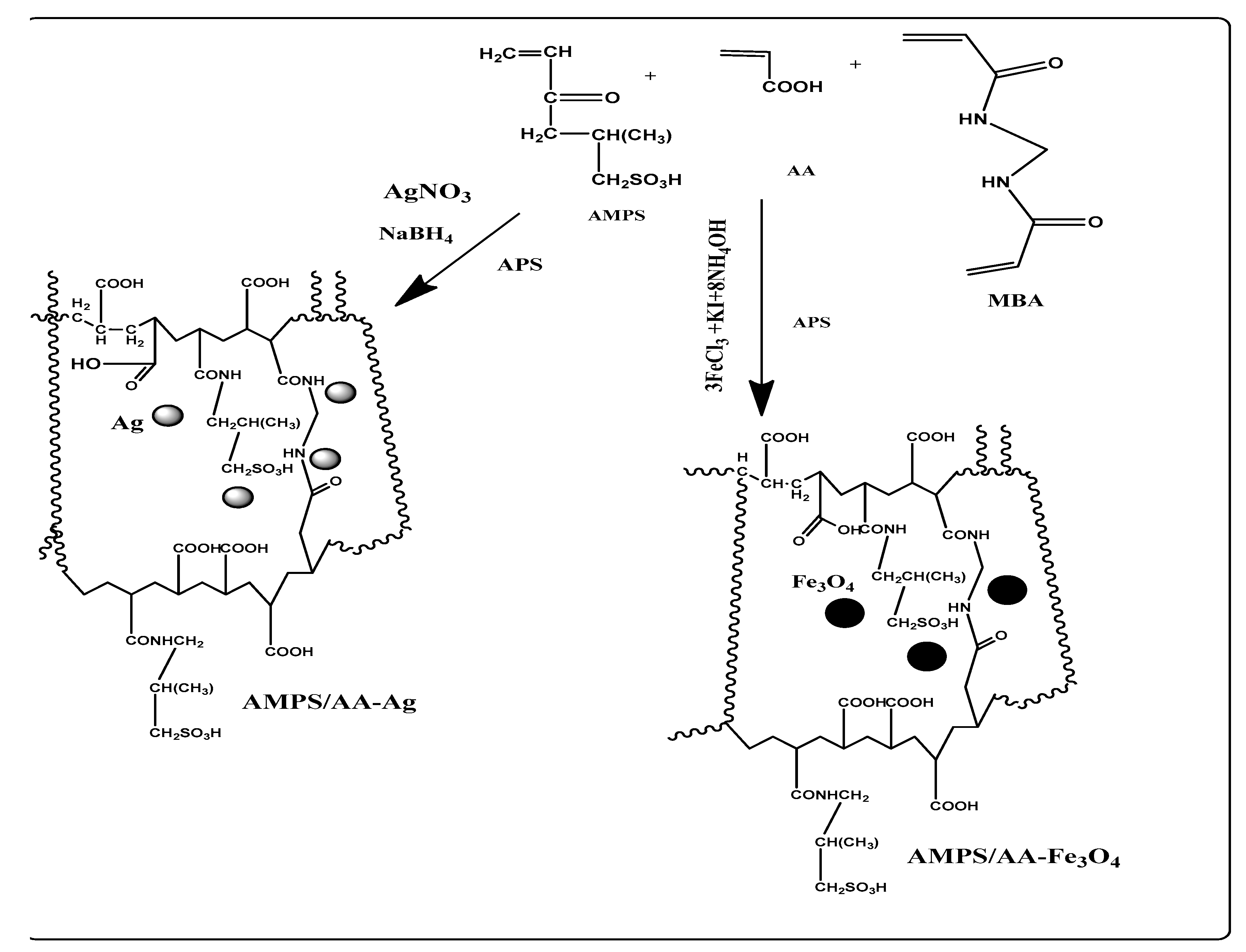
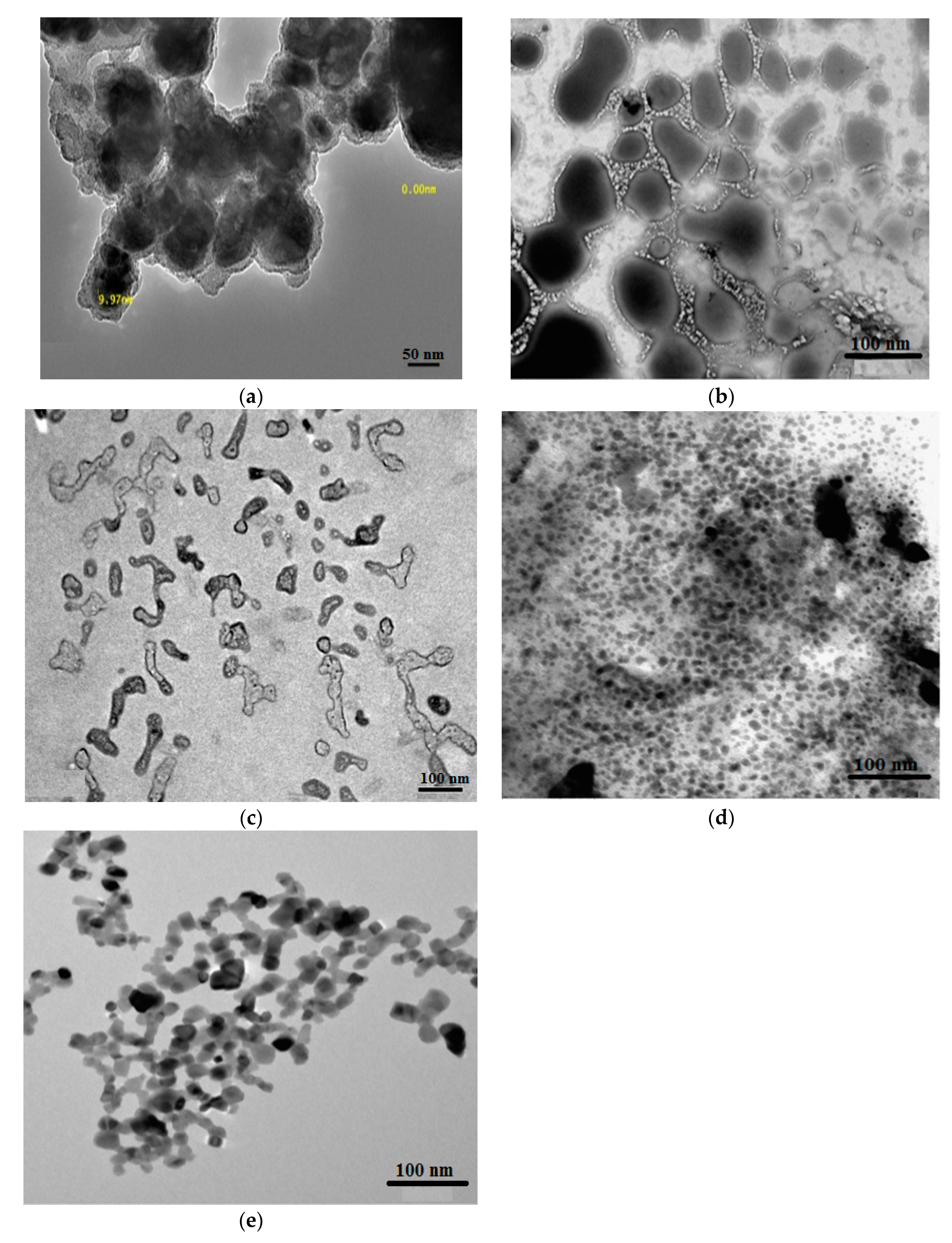
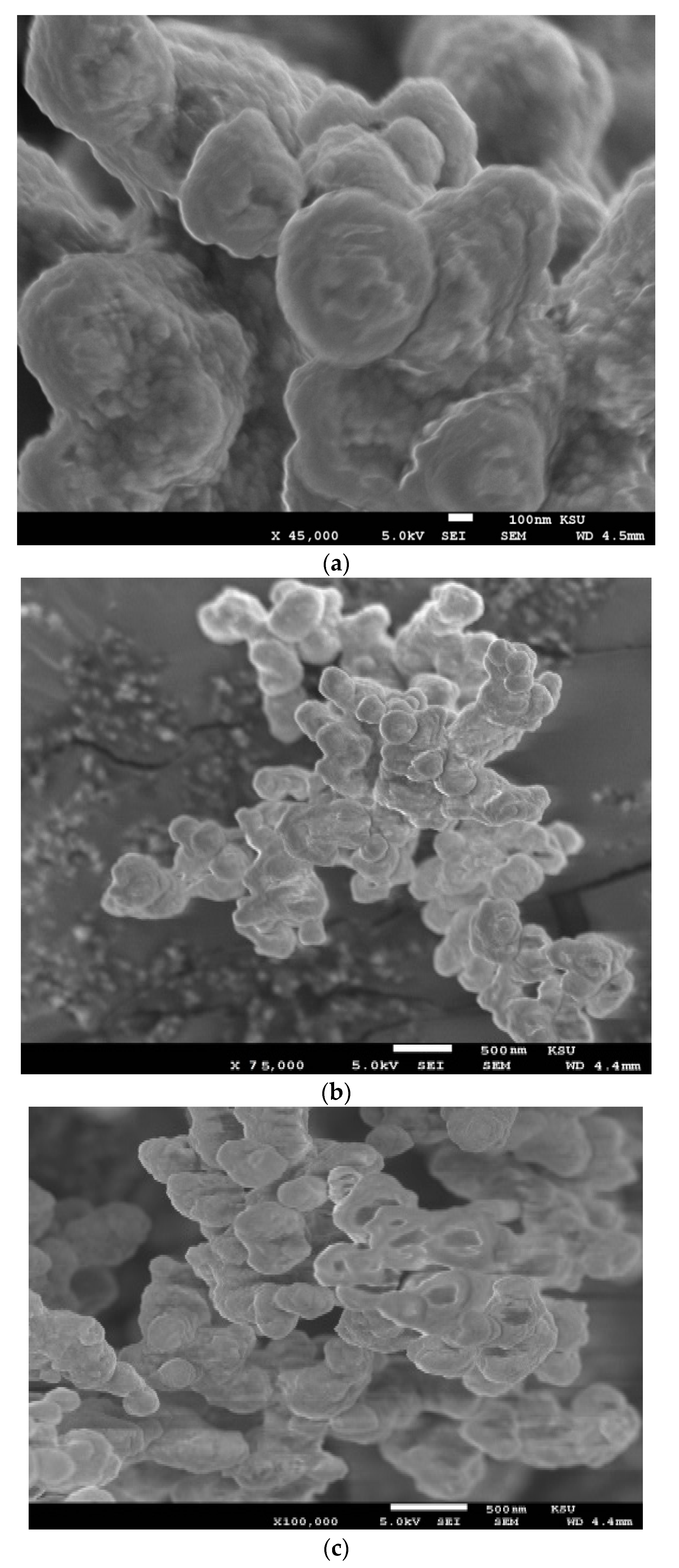
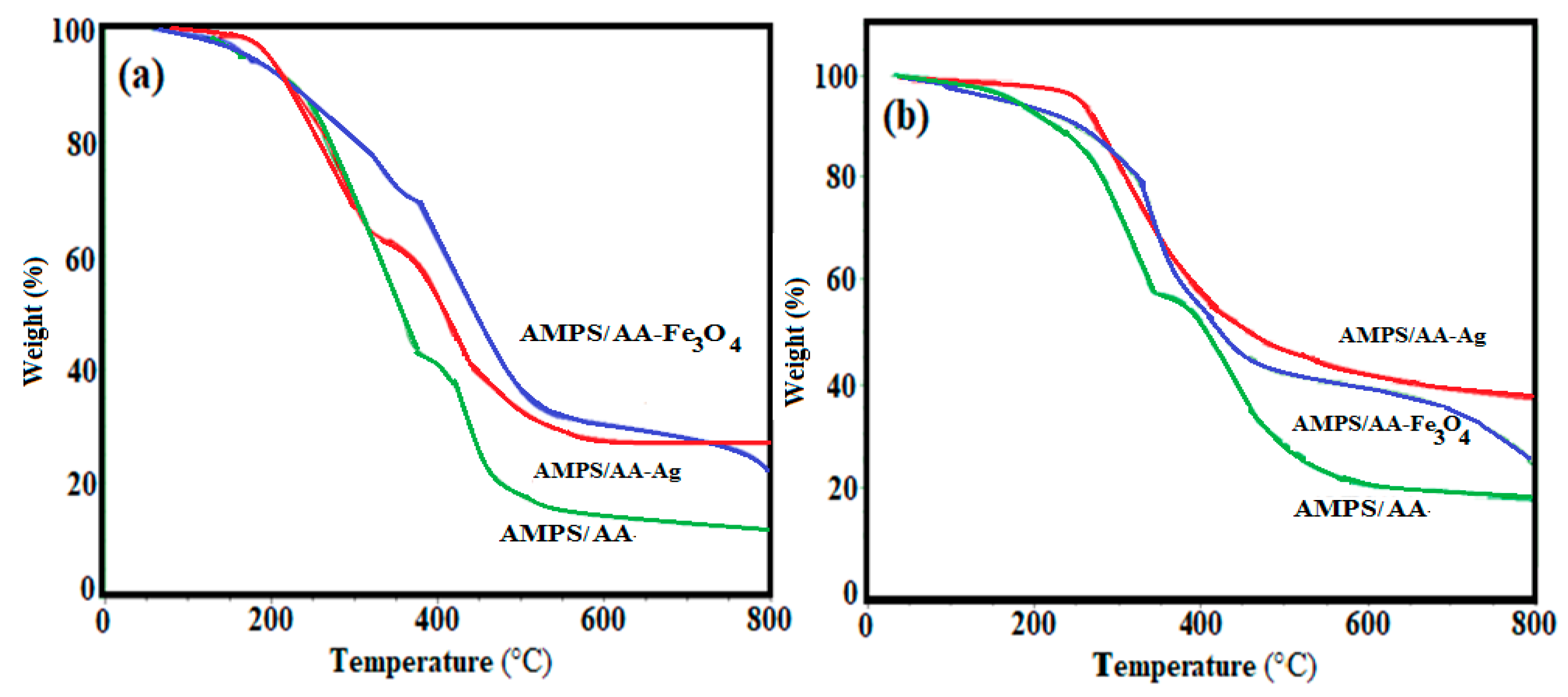


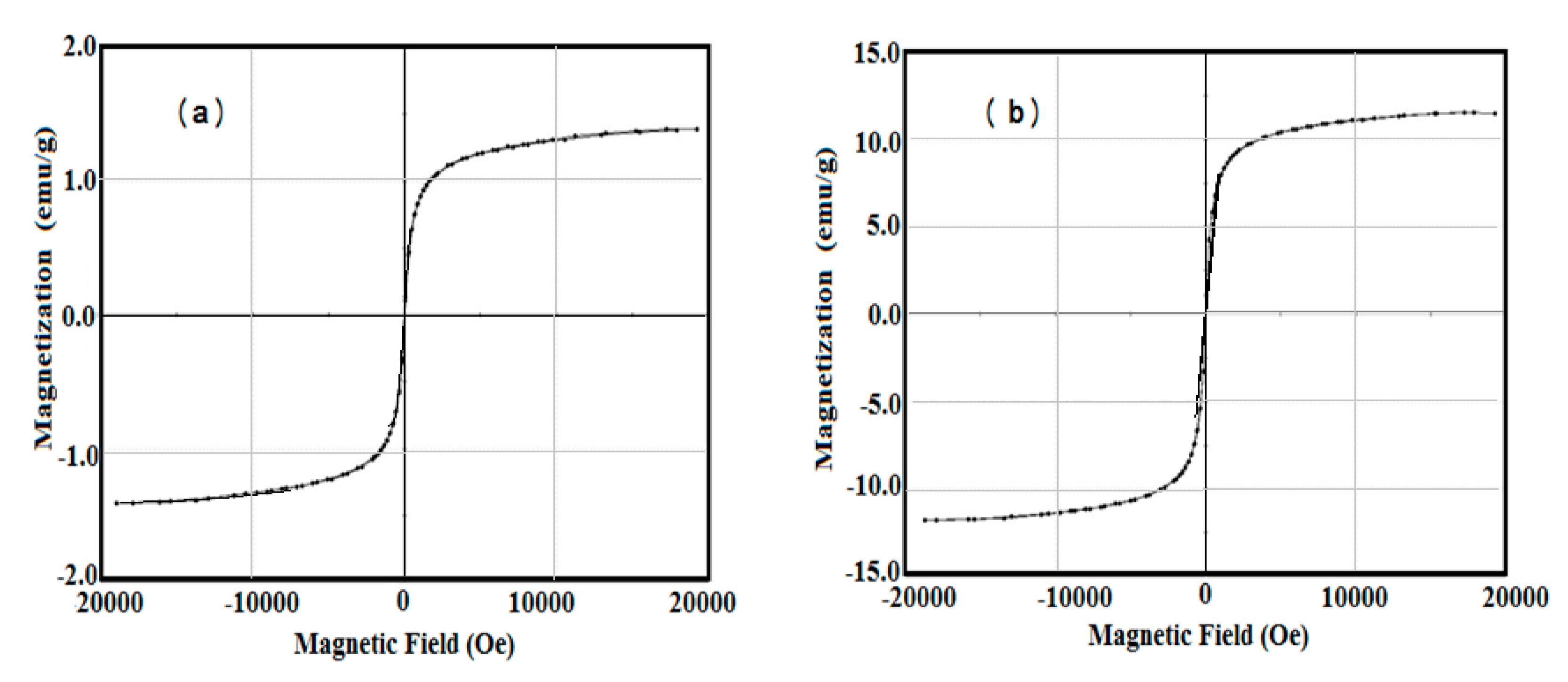
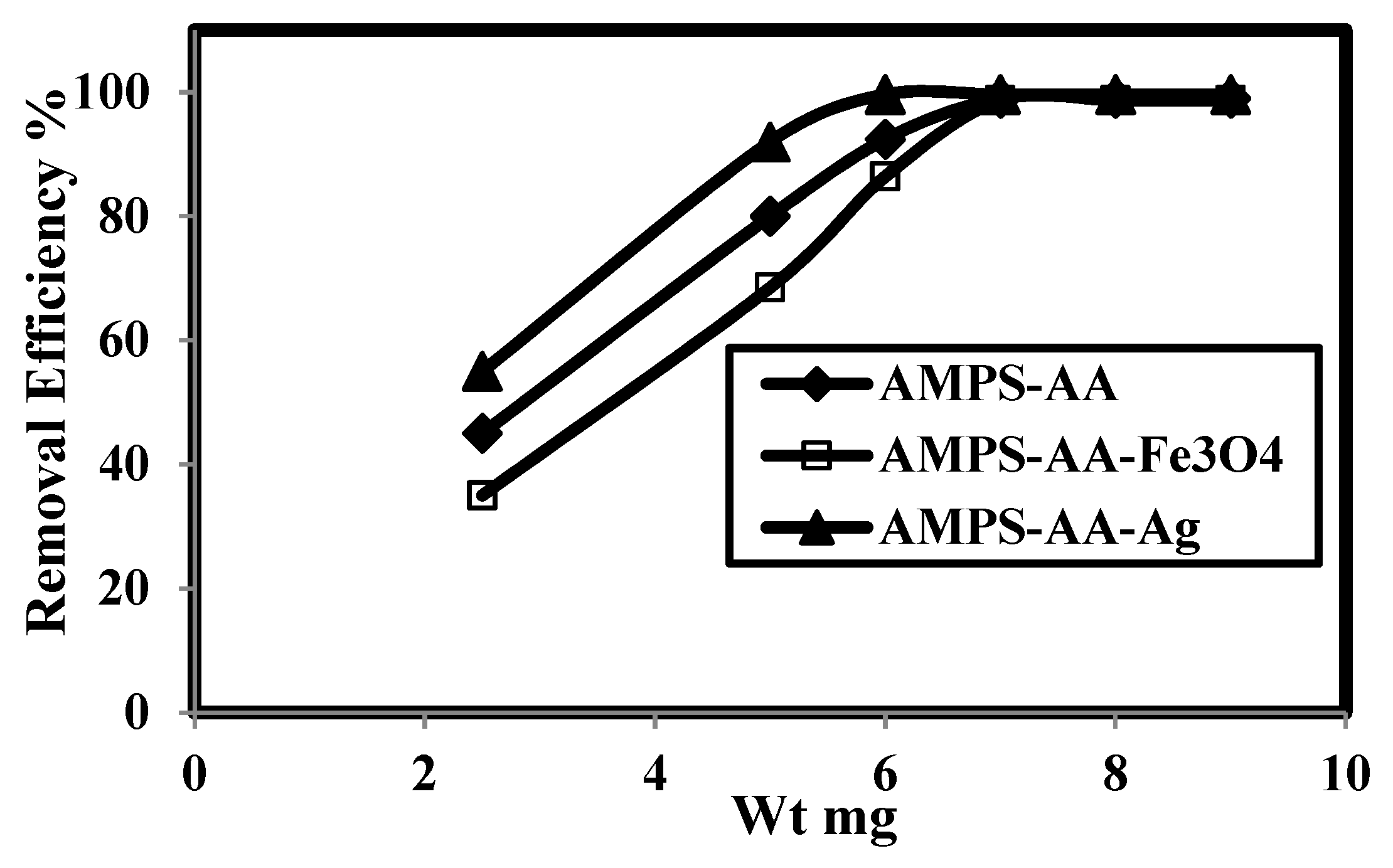
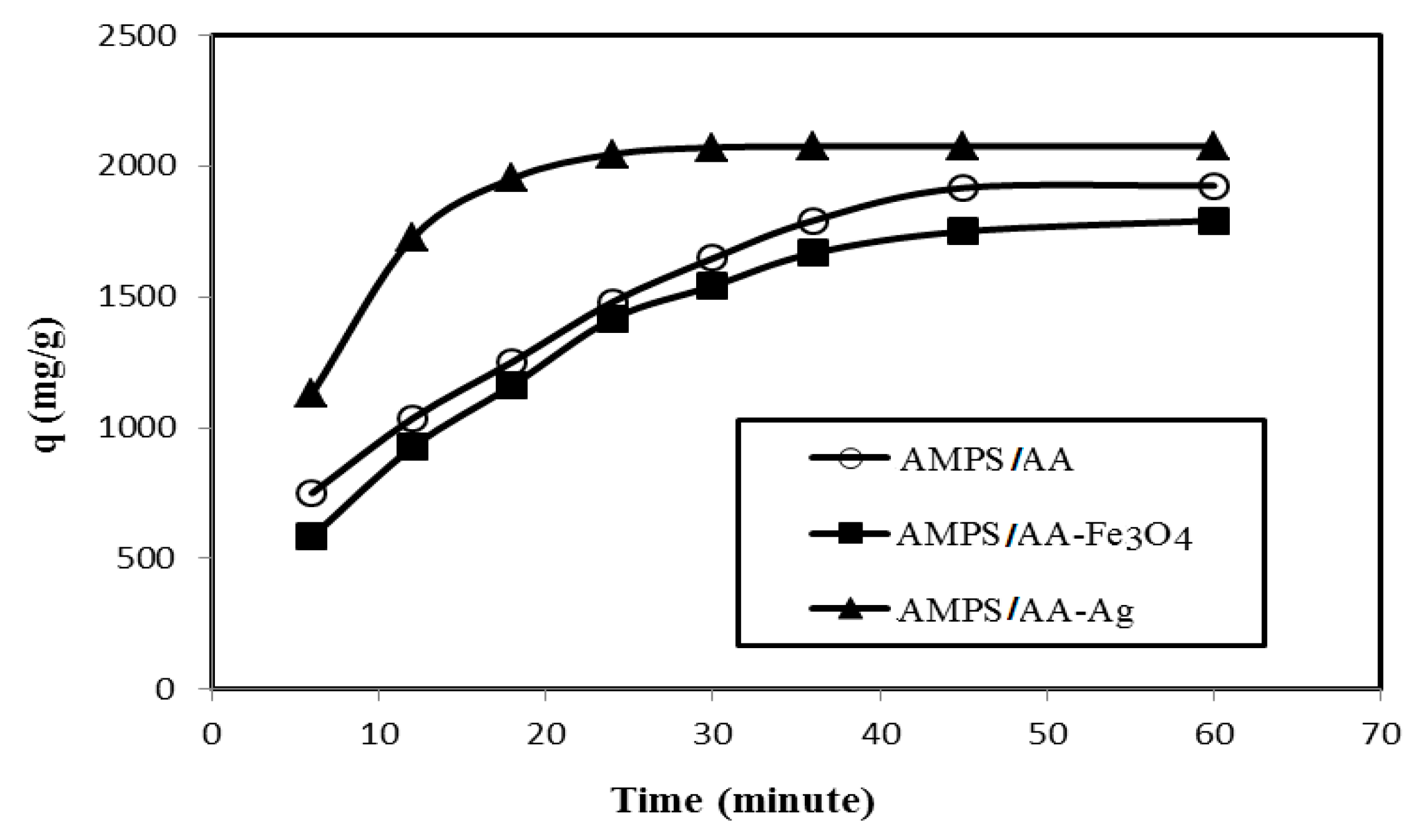
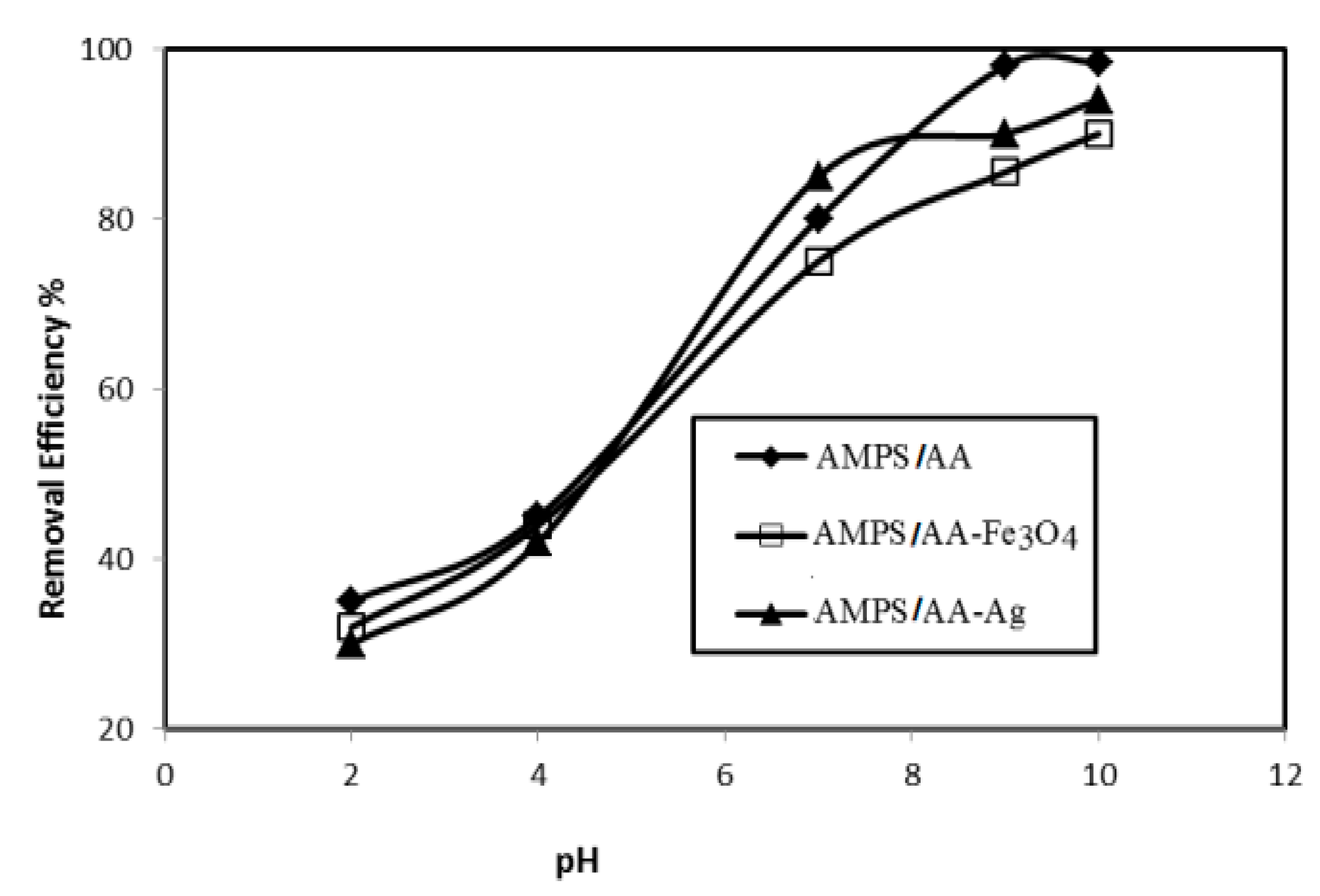
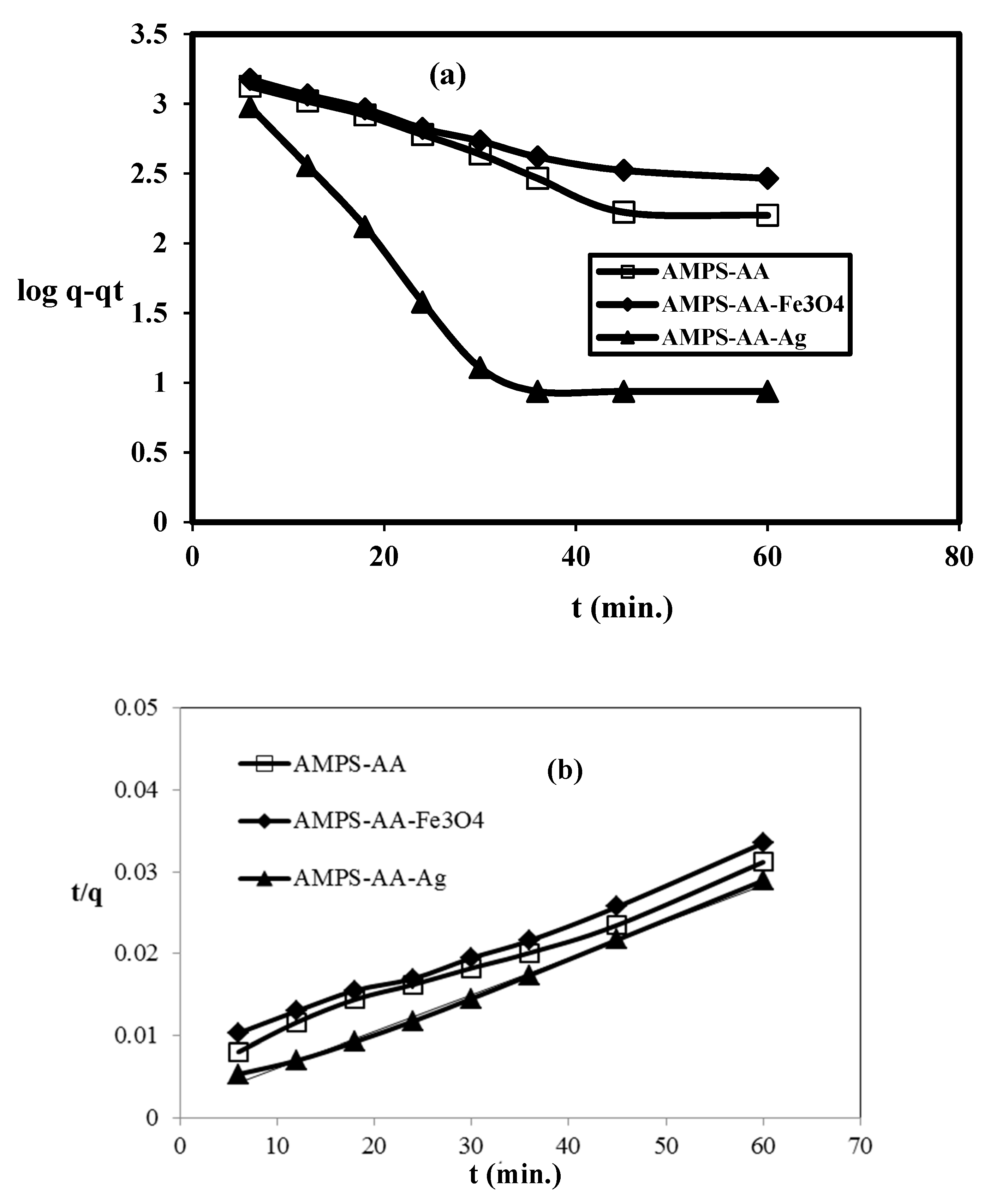

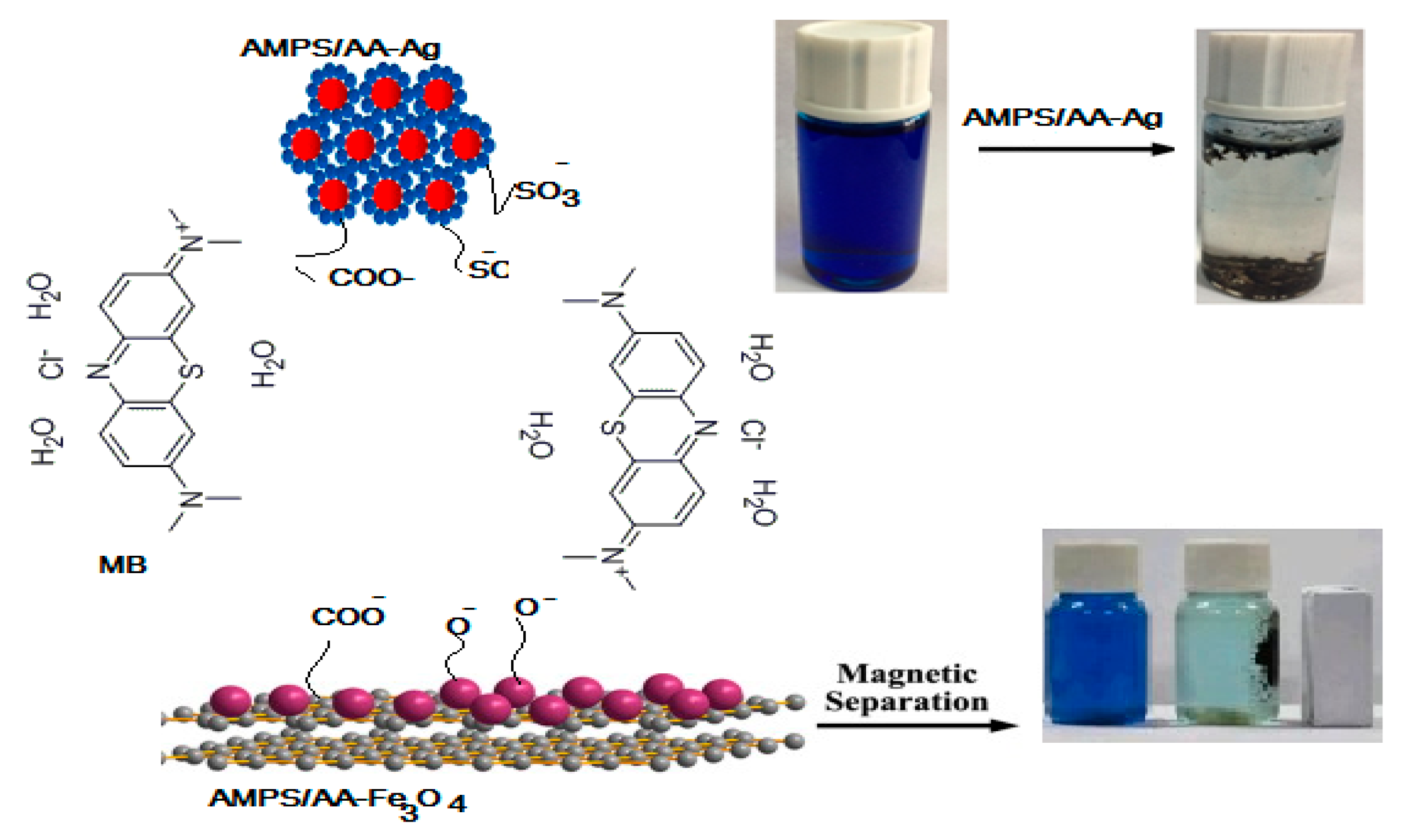


| Composites | Degradation Steps (°C) | Weight Loss (wt.%) | DT (°C) | T10% (°C) | R% at 750 °C (wt.%) |
|---|---|---|---|---|---|
| AMPS/AA hydrogel | 25–100 | 0 | 100 | 240 | 12 |
| 100–370 | 49 | ||||
| 370–550 | 33 | ||||
| 550–800 | 6 | ||||
| AMPS/AA microgel | 25–250 | 8 | 80 | 260 | 10 |
| 260–350 | 48 | ||||
| 350–650 | 34 | ||||
| AMPS/AA-Ag hydrogel | 25–250 | 10 | 150 | 250 | 34 |
| 250–550 | 51 | ||||
| 550–750 | 5 | ||||
| AMPS/AA-Ag microgel | 25–270 | 10 | 170 | 270 | 44 |
| 270–400 | 41 | ||||
| 440–750 | 5 | ||||
| AMPS/AA-Fe3O4 hydrogel | 25–250 | 22 | 80 | 240 | 29 |
| 250–550 | 40 | ||||
| 550–750 | 9 | ||||
| AMPS/AA-Fe3O4 microgel | 100–300 | 15 | 70 | 250 | 37 |
| 300–450 | 40 | ||||
| 450–650 | 8 |
| pH | Zeta Potential (mV) | ||
|---|---|---|---|
| AMPS/AA | AMPS/AA-Fe3O4 | AMPS/AA-Ag | |
| 4 | −9.22 ± 1.2 | −43.56 ± 0.50 | −10.9 ± 1.50 |
| 7 | −29.57 ± 1.0 | −29.42 ± 0.35 | −61.06 ± 2.50 |
| 9 | −11.57 ± 1.5 | −25.3 ± 0.55 | −5.01 ± 0.30 |
| Sample | Ms (emu/g) | Mr (emu/g) | Hc (G) |
|---|---|---|---|
| AMPS/AA-Fe3O4 hydrogel | 1.4 | 29.4 | 12.48 |
| AMPS/AA-Fe3O4 microgel | 11.56 | 6.97 | 9.04 |
| Crosslinked Polymer and Its Nanocomposites | qexp (mg g−1) | Pseudo-Second-Order Kinetic | Pseudo-First-Order | ||||
|---|---|---|---|---|---|---|---|
| Parameters | Kinetic Parameters | ||||||
| R22 | qcalc. (mg g−1) | K2 (g mg−1min−1) 10−5 | R12 | qcalc. (mg g−1) | K1 (min−1) 10−2 | ||
| AMPS/AA | 1980 | 0.99 | 2500 | 4.15 | 0.95 | 1686 | 0.0442176 |
| AMPS/AA–Fe3O4 | 1930 | 0.99 | 2500 | 5.7 | 0.94 | 1584 | 0.032242 |
| AMPS/AA–Ag | 2274 | 0.99 | 2500 | 6.95 | 0.78 | 639.7 | 0.0925806 |
© 2019 by the authors. Licensee MDPI, Basel, Switzerland. This article is an open access article distributed under the terms and conditions of the Creative Commons Attribution (CC BY) license (http://creativecommons.org/licenses/by/4.0/).
Share and Cite
Atta, A.M.; Gafer, A.K.; Al-Lohedan, H.A.; Abdullah, M.M.S.; Tawfeek, A.M.; Ezzat, A.O. Hybrid Ionic Silver and Magnetite Microgels Nanocomposites for Efficient Removal of Methylene Blue. Molecules 2019, 24, 3867. https://doi.org/10.3390/molecules24213867
Atta AM, Gafer AK, Al-Lohedan HA, Abdullah MMS, Tawfeek AM, Ezzat AO. Hybrid Ionic Silver and Magnetite Microgels Nanocomposites for Efficient Removal of Methylene Blue. Molecules. 2019; 24(21):3867. https://doi.org/10.3390/molecules24213867
Chicago/Turabian StyleAtta, Ayman M., Amany K. Gafer, Hamad A. Al-Lohedan, Mahmood M. S. Abdullah, Ahmed M. Tawfeek, and Abdelrahman O. Ezzat. 2019. "Hybrid Ionic Silver and Magnetite Microgels Nanocomposites for Efficient Removal of Methylene Blue" Molecules 24, no. 21: 3867. https://doi.org/10.3390/molecules24213867





